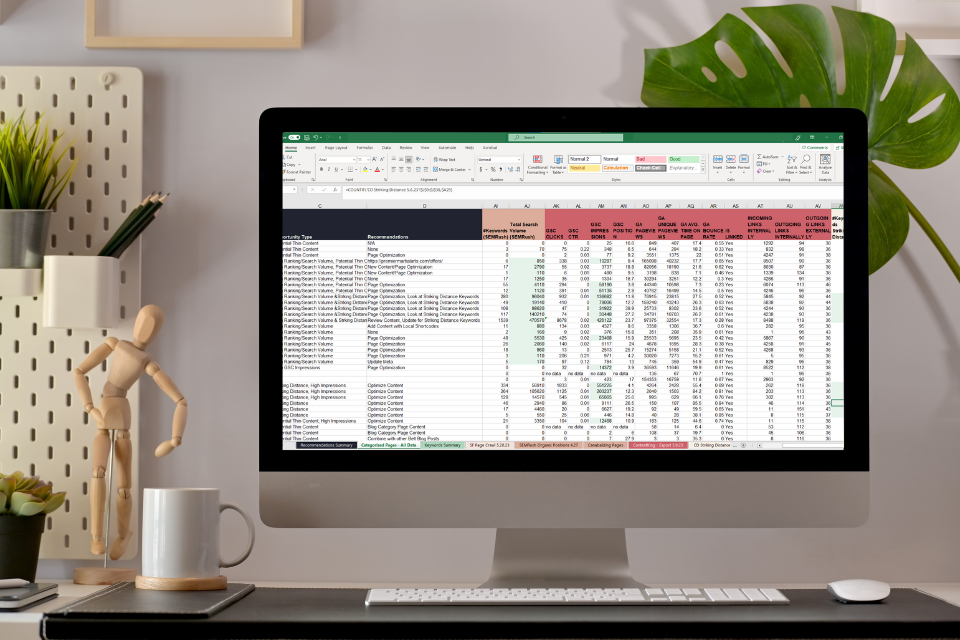A content audit is…well, exactly what it sounds like. During a content audit, we look at all the content on a website so we can understand the big picture. Even for smaller websites, this is an important part of your SEO strategy and your content marketing strategy. The beauty of our content audit process is that it’s a little different for each client. For smaller sites, our audits are focused on improving the content we have and looking for opportunities for new content whether it’s new web pages, blog posts, or product descriptions. For larger, more mature sites, we often spend a significant amount of time determining if content should be removed, merged, or updated. While all content audits may not look the same, they all have the same key components and they all result in valuable insight that feeds your SEO strategy.

Content Audit Goals
Just as the content audit itself is unique for each client, the goals will vary based on the organization’s business goals and level of SEO efforts. Goals for your content audit may include:
- Improving SEO: A Trebletree, this is always a goal and the primary reason we complete content audits for our clients is to improve SEO. There are many findings in our content audits that improve your rankings. When combined with a technical audit and a prioritized tag audit, we have the whole picture and can make recommendations on where your SEO strategy should focus.
- Identify High-Performing Content: Understanding which pieces of content are most successful can help you replicate that success in the future. This could be content that is driving a lot of traffic, generating leads, or achieving other important metrics. We also want to keep a close eye on this content to ensure it continues to perform well.
- Identify Low-Performing Content: Conversely, understanding which pieces of content are underperforming can help you make decisions about whether to improve or remove them.
- Ensure Content Relevance and Accuracy: Content that is outdated or no longer relevant can hurt your brand’s credibility. An audit can help you identify content that needs to be updated or removed. That blog post on trends in your industry from 2003 is not useful and may even be hurting your rankings. Sometimes, you just gotta let go.
- Content Gap Analysis: A content audit can help you identify topics or areas that you haven’t covered yet but should be based on your audience’s needs and interests.
- Improve User Experience: An audit can also help you understand how your content is structured and whether it’s easy for users to find and navigate your content.
- Align Content with Business Goals: Over time, business goals and strategies can shift. A content audit can ensure that your content is still aligned with your current business objectives.
- Inform Future Content Strategy: Overall, the insights gained from a content audit should inform your future content strategy. This includes decisions about what type of content to create, how to structure and organize it, and how to optimize it for both SEO and user experience.
Remember, the goals of a content audit can differ based on the needs and objectives of your organization, so it’s important to clearly define what you hope to achieve before you begin the audit. Before we start the content audit process, we like to make sure we understand what an organization is expecting to get out of the audit.

What to Include in a Website Content Audit
There’s a lot that goes into a content audit and we’ll get into that more below, but there are two primary perspectives when we perform a content audit. First, we look at all the current content from a page perspective. It starts with a crawl of the website to get a full page list and then we’ll pull all our data into that list to see everything that we can about each page. The other perspective we look at is from the keyword view. We’ll look at all the keywords a site ranks for as well as keywords the organization would like to rank for. It’s important to do keyword research before your content audit so that you can understand what keywords are important to your business. We’ll pull in data on the site’s current rankings by keyword and look for opportunities to increase and add ranking keywords.
5 steps to Perform a website content audit
STEP 1 | Gathering Your Data
The first step when you conduct a content audit is gathering all the data you’ll need to make informed decisions. This data can come from many different locations depending on what tools you have at your disposal. Here’s the standard list of data we pull into our content audit template and our preferred source:
- Page Lists
Screaming Frog is our go-to for site crawls and a great place to start when working on a content audit. This is also a good place to get tag data (the page titles, meta descriptions, and headings) if you haven’t already completed a prioritized tag audit. You can combine your tag audit with your content audit, but we prefer to address that prior to our full content audit. Updating missing, duplicate and poor tags is a high priority for a site so we choose to address that first. Content audits can be time-consuming and this allows us to make impactful changes more quickly.
- Organic Rankings & Keywords
To see how our pages are ranking and look for keyword opportunities we’ll pull our organic positions report from SEMRush. This data is used in both our page analysis and our keyword analysis. For clients that have access to the enterprise SEO tool Conductor, we will also pull a keyword performance report. If you’re not tracking target keywords in a tool like Conductor, it’s important to also pull in your keyword list from your keyword research.
- Google Analytics & Google Search Console
For our clients that have access to ContentKing, pulling this information as well as other page-level insights is as simple as one report, however, even without access to ContentKing, you can still pull most of this information from Google Analytics and Google Search Console. In GSC we’re looking for impressions, position, clicks, and CTR. This data helps us make decisions on which content to prioritize. From Google Analytics, we’re looking at pageviews, bounce rate, and time on page. These analytics give us insight into the quality of the content from a user perspective.
- Striking Distance Report
This is a report that can be easily pulled from Conductor, however, you can also pull your rankings and filter them to look at those in positions 11-20. Those keywords that are currently on page two are a prime opportunity for improvement. Oftentimes, simple updates to these pages can push you up in rankings, getting the coveted page one position.
- Competitor Rankings
Another benefit of Conductor is the ease of tracking competitors. We pull in Conductor’s rank comparisons to see how pages are performing against our competitors. You can also pull competitor data from another SEO monitoring tool. Looking at our competitor rankings helps us find opportunities and address issues that may have us falling behind the competition.
STEP 2 | Organizing and Configuring Your Data
Now the fun really begins. If you’re not a fan of Excel and aren’t comfortable with lots of formulas, it’s best to find someone that does. With all our data from different sources pulled into one Excel Workbook as separate sheets, it’s time to start pulling things together. As I mentioned above, we have two primary summaries that inform many of our recommendations. The content audit spreadsheet is where we’ll spend the majority of our time during the audit.
Data by Page
For our page-level data, we start with our site crawl to bring capture all the page URLs on our site. From there we’ll use VLOOKUP formulas to pull in our crawl information, Google Search Console data, and Google Analytics insights. We also use COUNTIF formulas to summarize keyword data for each page.
Data by Keywords
Our first step is to create a deduplicated list of all keywords we are ranking for or are targeting. This is the start of our keyword summary. From there we’ll pull data from SEMRush and Conductor to help us see a full picture for each keyword.
Cannibalizing Pages
“Cannibalizing content” refers to a situation where multiple pages on your website are competing for the same or similar keywords in search engine rankings. This can lead to confusion for search engines, and instead of helping your website rank better, it can actually dilute your SEO efforts and negatively affect your website’s visibility in search results.
In other words, when multiple pages on your site have the same target keyword, they end up competing with each other for ranking in search results, rather than complementing each other’s SEO efforts. This is called keyword cannibalization. The search engine may struggle to determine which page is the most relevant for the target keyword, and as a result, all of the competing pages may suffer in keyword rankings.
To easily see possible keyword cannibalization pages, we’ll create a pivot table to look at keywords that have multiple ranking pages on the site.

STEP 3 | Sorting and Analyzing
With all our data in one place, we can put our detective hat on and start looking at our content from all angles. This is where the aforementioned goals come in as we look at those areas that are the most important to the organizations.
From the page-level data, a few of the things we look at are:
- High Search Volume pages – these are valuable pages that we want to keep an eye on to make sure they continue to bring home the bacon. We’ll also look at these pages to make sure the website content is engaging.
- Thin Website Content – We’ll look at pages that have low word counts to see if there are pages that don’t have sufficient content or keyword rankings and a great user experience.
- Pages with keywords in striking distance – These are prime candidates for attention.
- Pages not ranking – For this category, we usually need to dig in and review each page individually to make a recommendation. If these pages are not essential to the organization’s website user, it may be best to remove them from the site.
From a keyword perspective, we look at things like:
- Is there a target keyword or keywords that we aren’t ranking for? Do we need new website content around that topic or do we already have a page on the topic that is not ranking well?
- We also look at keywords where our competitors are ranking higher for us. Is there valuable content that they are providing that our site does not?
- Are there keywords where our rankings are falling? Maybe we haven’t updated our website content recently or maybe there’s a technical issue on that page. When we see keyword rankings falling, we always want to dig in and try to figure out why.

STEP 4 | Making Recommendations
At this point, we’ve usually identified a wealth of potential updates we could make and it’s time to prioritize and make recommendations. SEO is always a work-in-progress and you can’t do everything at once. The key to a winning SEO strategy is consistent improvement. So we take a look at all the opportunities and figure out which ones will have the biggest impact. We also take into consideration the level of effort for each optimization. For example, writing a quality new page on a certain topic is much more time-consuming than removing non-ranking outdated pages. Anything that has a HIGH expected impact and a LOW level of effort should be tackled first. From there, we make decisions based on the time available for SEO work and the organization’s goals.
STEP 5 | Act on Your Content Audit Findings
Now it’s time to get to work. For our SEO clients, we map out a content plan for the next six months to a year. This includes future content creation to close content gaps, on-page SEO optimizations, and even updating the page meta description to increase conversion. It’s important to give yourself a realistic roadmap and not try to fix everything at once. Small, steady improvements will have a much larger impact than an overwhelming to-do list that keeps getting put off.
How a Content Audit Improves Your SEO Results
Well, let’s be clear, the audit itself does not improve your SEO, but the old adage applies, knowledge is power. The content audit is the fuel that powers all your SEO content work. From your content audit, you’ll have a clear picture of what you have, what you need, and where you need to make improvements. It is the action taken after your content audit that really improves your SEO results. So, if you take the time to do an audit or you pull in an expert, don’t just let your audit sit without taking action

Deciding What Content to Keep, Kill, and Clean Up
The process of deciding which content to keep, kill, or clean up after a content audit can be a challenging task. The goal is to enhance the quality and relevancy of your content, while also optimizing for SEO. Here’s a simple guide on how to make those decisions:
- Keep: If the content is performing well in terms of traffic, engagement, conversions, or other key metrics, and it’s still accurate and relevant, then it’s usually a good idea to keep it as it is. High-performing content that ranks well for targeted keywords and aligns with your business objectives should generally be preserved. This doesn’t mean you can forget it and those valuable pages should be continually monitored to make sure they stay that way.
- Update/Clean Up: Content that is outdated, slightly off-topic, not fully optimized for SEO, or has low engagement may need to be updated or cleaned up. This could involve refreshing the information, optimizing it for relevant keywords, improving the formatting, adding internal links, or other updates. Content that isn’t performing well but is still relevant to your business or target audience may also fall into this category.
- Consolidate: If you find multiple pieces of content that cover the same or similar topics or have duplicate content(and are therefore likely competing with each other in search results), it could be a good idea to consolidate them into one comprehensive piece. This can help prevent keyword cannibalization and provide a better user experience.
- Kill/Delete: Outdated content, irrelevant, or low-quality should generally be removed. This could include content that no longer aligns with your business goals, content that targets keywords that aren’t relevant to your business, or content that has consistently performed poorly in terms of traffic, engagement, conversions, etc. Before deleting, consider if the URL has inbound links or receives significant traffic, in which case a 301 redirect may be needed to maintain SEO value.
- Repurpose: Some content may not be performing well in its current format but could be valuable if repurposed. For example, an old blog post might make an engaging infographic or a popular video could be turned into a detailed blog post.
Remember, these are general guidelines and the exact approach may vary depending on your specific situation. It’s important to keep your overall content strategy and business goals in mind when deciding what to do with each piece of content. And don’t forget, after any significant changes, monitor performance to see if your updates are having the desired impact. If not, don’t panic – sometimes finding just the right optimization takes a few tries. Learn from what works and what doesn’t and apply that to other pages on your site.

How Often Should Content Audits Be Done?
An SEO content audit is a tool that informs your SEO strategy and can uncover opportunities to improve your SEO performance. We recommend a content audit be completed at least once a year. If you’re making frequent content updates and additions to your site, you may even want to refresh your content audit twice a year or more. In between audits, it’s important to use your analytics tools to track your progress and see how your optimized website pages are doing.
Looking for help with a content audit for your organization? We specialize in full-service SEO and our content audit services will open your eyes to many opportunities for improvement. Let’s chat.




